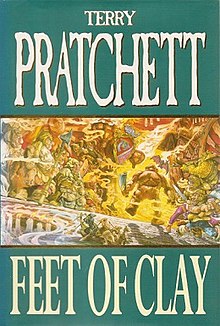Feet of Clay (novel)
Feet of Clay is a fantasy novel by British writer Terry Pratchett, the nineteenth book in the Discworld series, published in 1996. The story follows the members of the City Watch, as they attempt to solve murders apparently committed by a golem, as well as the unusual poisoning of the Patrician, Lord Vetinari.
 First edition | |
| Author | Terry Pratchett |
|---|---|
| Cover artist | Josh Kirby |
| Language | English |
| Series | Discworld 19th novel – 3rd City Watch novel (4th story) |
| Subject | Cop novels, slavery, robots and artificial intelligence
|
| Genre | Fantasy |
| Publisher | Victor Gollancz |
Publication date | 1996 |
| ISBN | 0-575-05900-1 |
The title is a figure of speech from Hebrew scripture (see feet of clay) and the script used in the book to represent Morporkian being written by a golem resembles the Hebrew alphabet,[1] a reference to golems' origins in Jewish folklore.
Plot
Twelve of the city golems, clay creatures forced to obey the written instructions placed inside their heads, decide to create a "king" golem. They fashion a golem from their own clay and place in his head instructions that would fulfill their hopes: "Bring peace to the world", "Treat everyone fairly" and so on. They enroll the help of a priest and dwarf bread baker to write the sacred instructions and bake the clay, respectively; Meshugah, the "king" golem, is initially sent to work in a candle factory.
Around the same time, a cabal of Ankh-Morpork's guild leaders seeks to gradually depose the Patrician, replace him with Nobby Nobbs as the new king and rule the city through him.
To implement this, the cabal orders the golems' newly made king, Meshugah, to make poisoned candles and have them delivered to the palace. Vetinari is successfully poisoned, making him severely ill. Meshugah, however, is "overloaded" by all the different instructions his creators gave him, and goes "mad": he starts overworking and, when he finishes raw materials, he rampages through the city, and goes on to murder the priest and baker who took part in his creation.
At this point the City Watch steps in trying to solve the murders and the poisoning of Lord Vetinari. With the assistance of their new forensics expert dwarf Cheery Littlebottom, Commander Vimes and Captain Carrot slowly unravel the mystery.
Carrot and Dorfl, one of the golems, fight and defeat the golem king at the candlestick factory. Afterwards, Vimes confronts the city's chief heraldry expert, a vampire, who instigated the whole affair. Dorfl arrests him despite tenuous evidence and Vimes burns down all the heraldic record as retribution against the "elite" and "noble" plotters, who had happily and self-righteously sacrificed the lives of several "commoners" in the pursuit of their scheme.
In the end, Vetinari has recovered completely, Dorfl is sworn in as a Watchman, Vimes gets a pay raise, and the Watch House gets a new dartboard. Vetinari reveals to his assistant, Drumknott, that he had known of the plot for some time already. Vimes' rash actions in the pursuit of truth had considerably scared the city elite, which is precisely why Vetinari had let him continue: so that the plotters would know just how much worse off they'd be if Vetinari died.
Reception
Publishers Weekly described the book as "fantasy served with a twist of Monty Python, parody that works by never taking itself too seriously", with "sly puns" and "lively, outrageous characters".[2] The A.V. Club, conversely, emphasized the book's "intelligent wit and wordplay with a notable lack of punnery", praised Pratchett for the "complexity" of the politics and the "three-dimensional" nature of the characters, and noted that the "sword and sorcery" plot "doesn't insult the reader's intelligence" despite involving "the bumbling City Watch" and "a murderous enchanted statue".[3]
At the SF Site, Steven H Silver commended Pratchett for presenting "mysteries which can be solved with the clues provided", and stated that although the book does not have "quite as many laugh out loud moments as [previous Discworld novels]", it shows that Pratchett is "a novelist as well as a humorist".[4]
Gideon Kibblewhite reviewed Feet of Clay for Arcane magazine, rating it a 9 out of 10 overall.[5] Kibblewhite comments that "It's another gem from a master of comic fantasy."[5]
References
- "The Annotated Pratchett File". lspace.org. Retrieved 15 October 2018.
- "Fiction book review: Feet of Clay". Publishers Weekly. October 2, 1996. Retrieved December 28, 2017.
- Krewson, John (March 29, 2002). "Terry Pratchett: Feet Of Clay". The A.V. Club. Retrieved December 28, 2017.
- Silver, Stephen H. (January 14, 1997). "Terry Pratchett: Feet Of Clay". SF Site. Retrieved December 28, 2017.
- Kibblewhite, Gideon (July 1996). "The Great Library". Arcane. Future Publishing (8): 82.
External links
- Feet of Clay title listing at the Internet Speculative Fiction Database
- Annotations for Feet of Clay
- Quotes from Feet of Clay
- Synopsis of Feet of Clay
| Reading order guide | ||
|---|---|---|
| Preceded by Maskerade |
19th Discworld Novel | Succeeded by Hogfather |
| Preceded by Men at Arms |
4th City Watch Story Published in 1996 |
Succeeded by Jingo |